Containing the Franklin Fire: Malibu’s Struggle and Resilience
The Franklin Fire, which erupted late Monday night in Malibu, has scorched nearly 4,000 acres of Southern California’s scenic terrain. Amidst red-flag warnings and relentless Santa Ana winds, firefighters are beginning to make headway in containing this devastating blaze. The Rapid Growth of the Franklin Fire Fueled by strong winds and low humidity, the Franklin...
The post Containing the Franklin Fire: Malibu’s Struggle and Resilience appeared first on 1redDrop.
AI apps and agents that scale impact across your business
Despite significant investments in AI, many organizations struggle to convert that potential into compelling business outcomes.
Only a third of AI practitioners feel equipped with the right tools, and deploying predictive AI apps takes an average of seven months—eight for generative AI. Even then, confidence in these solutions is often low, leaving organizations unable to fully capitalize on their AI investments.
By streamlining deployment and empowering teams, the right AI apps and agents can help businesses deliver predictive and generative AI use cases faster and with greater results.
What’s slowing your success with AI applications?
Data science and AI teams often face lengthy cycles, integration hurdles, and inefficient tools, making it difficult to deliver advanced use cases or integrate them into business systems.
Custom fixes may offer a fast workaround, but they often lack scalability, leaving businesses unable to fully unlock AI’s potential. The result? Missed opportunities, fragmented systems, and growing frustration.
To address these challenges, DataRobot’s AI apps and agents help streamline deployment, accelerate timelines, and simplify the delivery of advanced use cases, without the complexity of building from scratch.
AI apps and agents
Delivering impactful AI use cases can be faster and more efficient with custom AI solutions. Specifically, DataRobot’s new features provide:
- Streamlined deployment by reducing the need for extensive code rewrites.
- Pre-built templates for business logic, governance, and user experience to accelerate timelines.
- The ability to tailor approaches to meet your unique organizational needs, ensuring meaningful results.
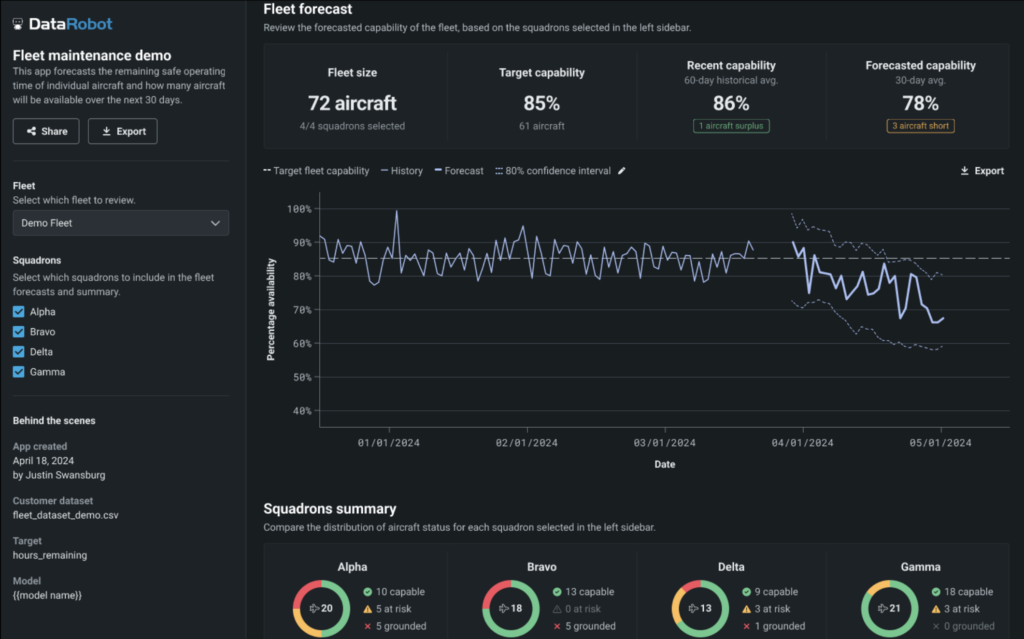
Collaborative AI application library
Disconnected workflows and scattered resources can bring AI deployment to a crawl, stalling progress. DataRobot’s customizable frameworks, hosted on GitHub, help teams establish a shared library of AI applications to:
- Start with a foundational framework.
- Adapt it to organizational requirements.
- Share it across data science, app development, and business teams.
These organization-specific customizations empower teams to deploy faster, enhance security, and foster seamless collaboration across the organization.
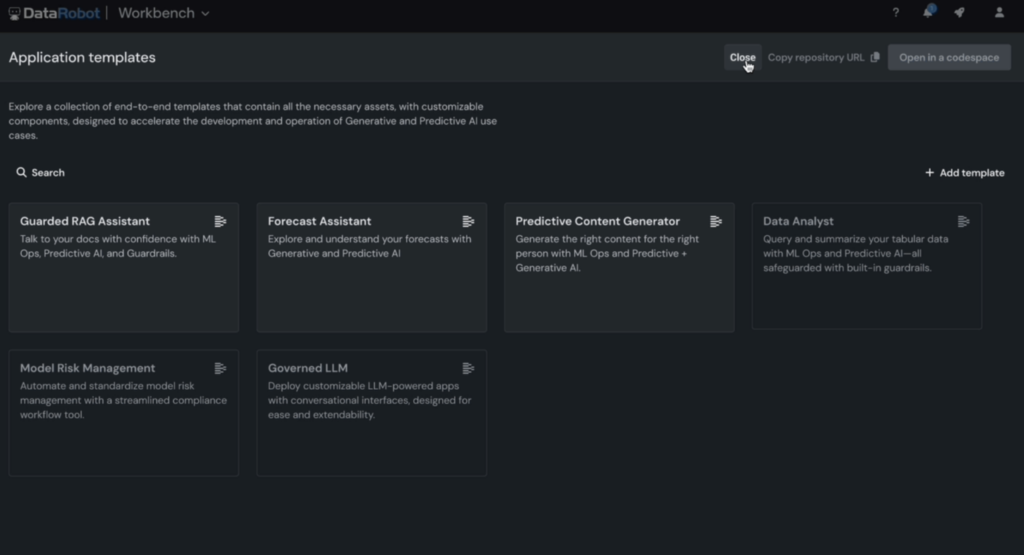
How to streamline fragmented workflows for scalable AI
Creating user-friendly AI interfaces that integrate seamlessly into business workflows is often a slow, complex process. Custom development and integration challenges force teams to start from a blank slate, leading to inefficiencies and delays. Simplifying app development, hosting, and prototyping can accelerate delivery and enable faster integration into business workflows.
AI App Workshop
Setting up local environments and generating Docker images often creates bottlenecks. Managing dependencies, configuring settings, and ensuring compatibility across systems are time-consuming, manual tasks prone to errors and delays.
DataRobot Codespaces now allow you to build code-first AI applications for your models using frameworks like Streamlit and Flask, simplifying development and enabling quick creation and deployment of custom generative AI app interfaces.
The new embedded Codespace support enhances this process by allowing you to easily develop, upload, test, and organize interfaces within a streamlined file system, eliminating common setup challenges.
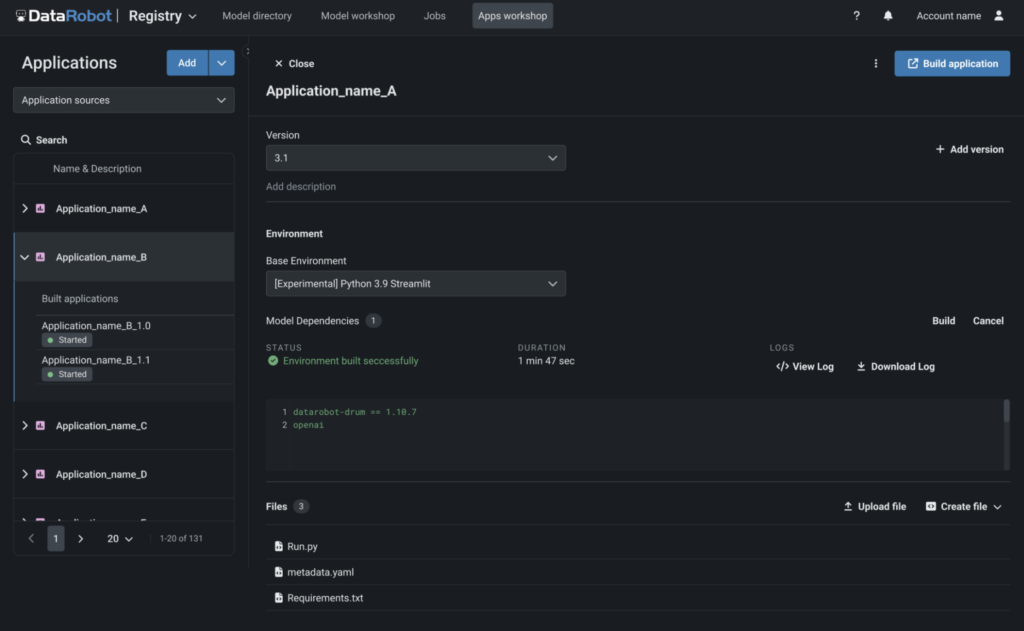
Q&A App
Another new DataRobot feature enables you to quickly create chat applications to prototype, test, and red-team generative AI models. With a simple, pre-built GUI, you can evaluate model performance, gather feedback efficiently, and collaborate with business stakeholders to refine your approach.
This streamlined approach accelerates early development and validation, while its flexibility allows you to customize or replace components as priorities evolve.
Adding custom metrics and conducting stress-testing ensures the application meets organizational needs, builds trust in its responses, and is ready for seamless production deployment.
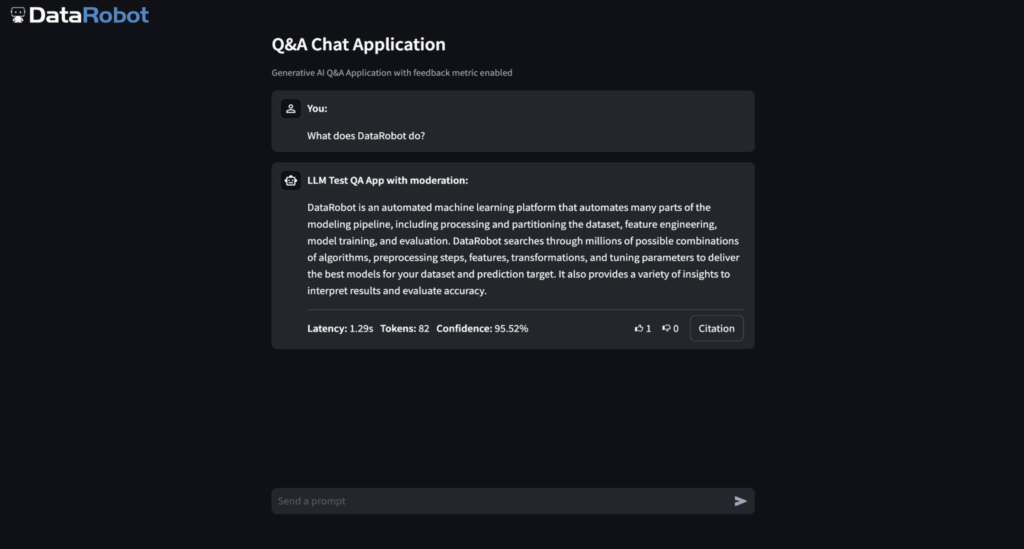
What’s holding back scalable AI applications?
Delivering scalable, trustworthy AI applications requires cohesion across workflows, tools, and teams. Without streamlined provisioning, standardization, and integration, delays and inefficiencies stall progress and stifle innovation.
The right tools, however, unify processes, reduce errors, and align outcomes with business needs.
Declarative API framework
DataRobot’s Declarative API Framework simplifies the development of scalable, repeatable AI applications for generative and predictive use cases, enabling teams to replicate work, save pipelines, and deliver solutions faster.
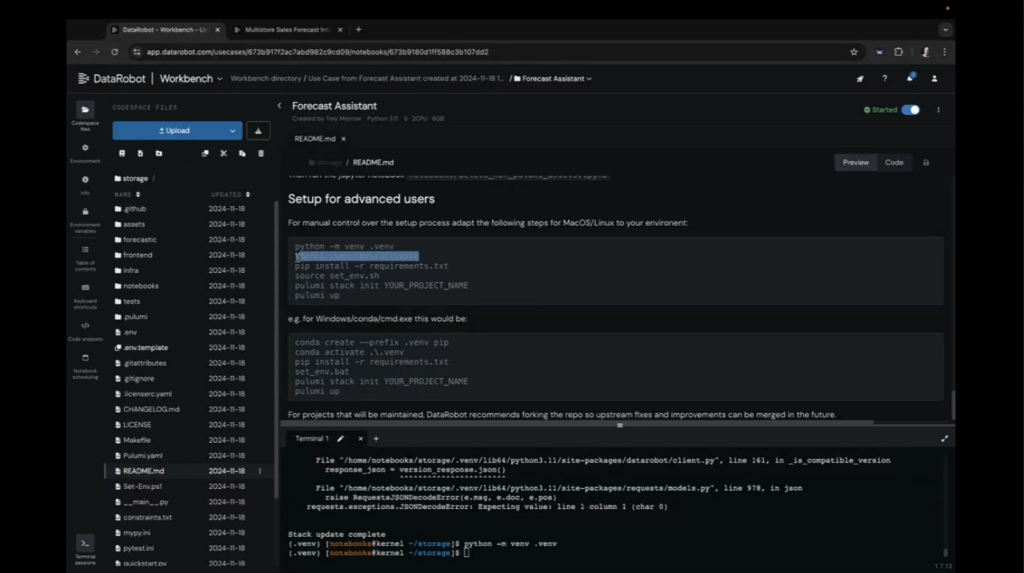
One-click SAP ecosystem embedding
Integrating AI models into existing ecosystems presents multiple challenges, including compatibility issues, siloed data, and complex configurations. DataRobot’s one-click integration with SAP Datasphere and AI Core simplifies this process by enabling you to:
- Seamlessly connect with minimal effort.
- Specify SAP credentials and compute resources.
- Bring models closer to your data for faster, more efficient scoring.
- Monitor deployments directly within DataRobot.
This integration minimizes latency, streamlines workflows, and enhances scalability, allowing your AI solutions to operate seamlessly at an enterprise scale.
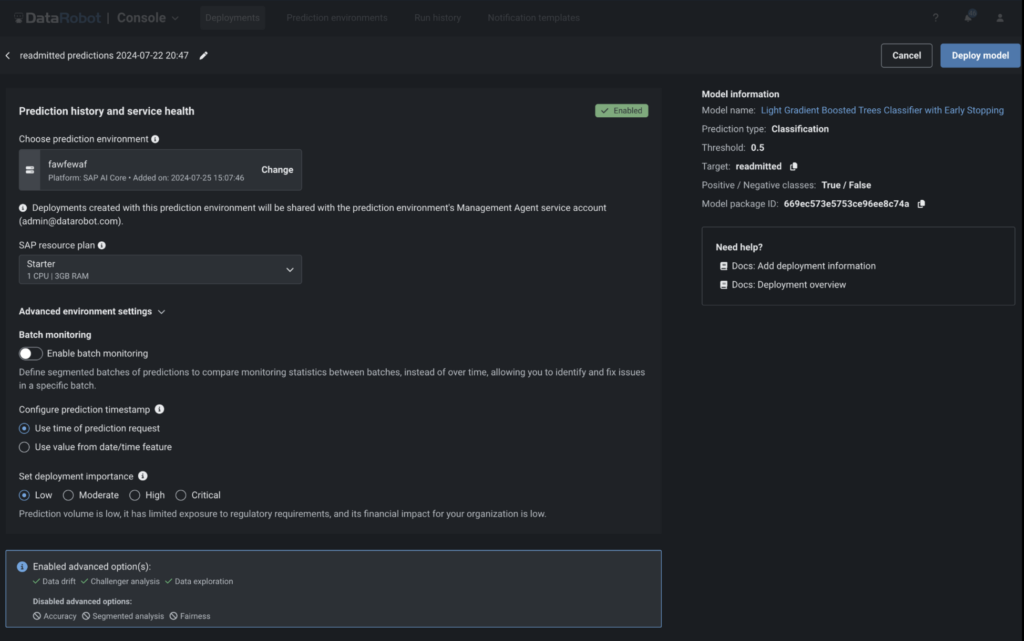
Transform your workflows with adaptable AI
Integrating AI shouldn’t disrupt your workflows—it should enhance them.
Imagine AI that adapts to your business: flexible, customizable, and seamlessly deployable. With the right tools, you can overcome challenges, deliver value faster, and ensure AI becomes an enabler, not an obstacle.
As you evaluate AI for your organization, the right AI apps and agents can help you focus on what truly matters. Explore what’s possible with AI apps that help you achieve enterprise AI at scale.
The post AI apps and agents that scale impact across your business appeared first on DataRobot.
Introducing Gemini 2.0: our new AI model for the agentic era
Introducing Gemini 2.0: our new AI model for the agentic era
Introducing Gemini 2.0: our new AI model for the agentic era
Introducing Gemini 2.0: our new AI model for the agentic era
Introducing Gemini 2.0: our new AI model for the agentic era
Introducing Gemini 2.0: our new AI model for the agentic era
Introducing Gemini 2.0: our new AI model for the agentic era
Introducing Gemini 2.0: our new AI model for the agentic era
Introducing Gemini 2.0: our new AI model for the agentic era
Introducing Gemini 2.0: our new AI model for the agentic era
Mobile robot forecast downgraded as macro-economic factors continue to bite
Role of Blockchain in the Real Estate Industry
Role of Blockchain in the Real Estate Industry
Real estate is one of the oldest industries in an economy. Still, these sectors also suffer from many disadvantages like higher transaction costs, longer time processes, and a general lack of transparency in this buying, selling, and property management process.
Technology advancements have influenced many businesses, and the real estate sector is no exception. Among them, blockchain is one technology that has had a significant impact. Blockchain is a decentralized digital ledger that securely and transparently records transactions across several computers.
Blockchain is increasingly utilized in various sectors and its distinguishing properties like preserving data integrity, decreasing the need for middlemen, and enabling smart contracts make it a promising solution for overcoming traditional real estate challenges.
Here, we’ll look at how blockchain is changing the real estate sector, addressing current issues and opening up new options for investors, buyers, and property managers.
How Blockchain Addresses The Challenges Of the Real Estate Industry
-
Transparency
Blockchain is a decentralized ledger, recording all transactions. This also reduces the possibilities of fraudulent activities, such as false documents or listings of properties. Buyers and sellers get a clear, verifiable history of ownership, so the integrity of transactions can be ensured.
-
Reduction of Middlemen
Blockchain allows peer-to-peer transactions, so buyers and sellers can conduct business directly with one another. This reduces the need for brokers, banks, and legal consultants, allowing the process to proceed faster and more efficiently. With fewer middlemen, the chance of human error is reduced.
-
Reduced Operational Costs
Removing the middleman leads to huge savings on fee-related issues with a real estate transaction. For example, a smart contract essentially includes a self-executed contract, which can even be coded into its direct application; most of these administrative duties are carried out automatically. This will create room for more percentages to buy in.
-
Improved Data Management.
All records on a blockchain are encrypted and spread across a network of computers, making them extremely resistant to hacking and data loss. This assures that property records, ownership information, and transaction histories are reliable and secure.
Blockchain Applications in Real Estate:
-
Tokenization
Blockchain technology allows properties to be divided into digital tokens, which represent fractional ownership. This technique democratizes real estate investment by allowing individuals to invest in tiny amounts of high-value assets. It also improves liquidity by allowing the purchase and sale of property shares on blockchain-based marketplaces.
-
Property Management
Landlords and property managers can use blockchain-based services to manage tenant contracts, collect rent, and track maintenance requests. This improves data management efficiency and reduces the chances of disputes. Several real estate businesses have started employing blockchain technology to handle rental payments and property management operations, providing landlords and tenants with a smooth experience.
-
Decentralization.
Decentralized property records are another area where blockchain has had a significant impact. Typically, traditional land ownership documents can be manipulated. However, blockchain technology assures that papers and data are preserved securely in a decentralized and irreversible manner. This eliminates any possibility of fraud or misinterpretation. Countries like Sweden and Dubai have experimented with blockchain-based land registries to reduce fraud and assure safe property transfers.
-
Crowdfunding
Blockchain is gaining popularity as a means of crowdfunding real estate projects. Tokenized assets help developers raise funds from several small investors, making new projects more easily funded. Platforms such as Fundrise and RealBlocks have already started blockchain-based real estate crowdfunding efforts, giving developers and investors an alternative option for finance or investments.
Challenges and Limitations of Blockchain Adoption in Real Estate
While blockchain has significant advantages for the real estate sector, there are a few obstacles that limit its widespread use. One of the primary challenges is regulatory and legal constraints. The legal frameworks governing real estate differ by country, and many countries lack legislation unique to blockchain-based transactions. This causes confusion and may delay the introduction of blockchain solutions. For example, compliance criteria for digital asset transactions have yet to be established, making it difficult for blockchain-based property transactions to obtain legal recognition.
Another problem is due to technological restrictions. Integrating blockchain technology into existing real estate systems can be difficult and expensive. Many traditional property databases were not designed to accommodate blockchain integration, which might cause data synchronization concerns. Furthermore, as the application of blockchain is still relatively new, there is a scarcity of trained individuals who understand both blockchain and real estate. So, deployment of blockchain technology can be difficult.
Market adoption and awareness are also key challenges. Although blockchain is gaining popularity, there is still a lack of awareness about how it works and the benefits it offers in the real estate business. Many stakeholders, such as property owners, brokers, and legal professionals, may be unwilling to adopt a new technology that they view as difficult.
Finally, concerns regarding scalability and cost can limit blockchain use. While blockchain can minimize expenses associated with middlemen, implementing solutions using blockchain involves a considerable upfront investment in technology and infrastructure. Due to the volume of transactions on the blockchain network grows, scalability concerns may occur, thereby slowing transaction processing time.
Benefits of Blockchain Technology for the Real Estate Industry
With important development ongoing, blockchain technology reportedly looks promising in the near future for the real estate segment. It is believed to see higher adoption in real estate on the back of rising development in technology and shift of legal jurisdictions. In some industry reports, growth will be high with rising interests in decentralized finance and other digital assets within the real estate market involving the application of blockchain technology. Further, with more companies experimenting with blockchain-based solutions, the industry as a whole will experience wider acceptance and use.
Emerging technologies such as AI and IoT will improve blockchain applications in real estate. Artificial intelligence can be combined with blockchain to automate property valuations and risk assessments, making the process faster and more accurate. The Internet of Things (IoT) can be combined with blockchain to improve smart property management by securely recording data from connected devices on the blockchain, allowing for improved tracking of building maintenance and energy usage.
For investors, blockchain will make real estate investments more accessible by tokenizing them, allowing for fractional ownership and eliminating entry hurdles. The smart contracts will raise property management standards for managers and landlords, simply because they will reduce expense costs and administrative duties. Governments must start implementing block-chain based land registries to be regarded as pivotal agents in this process. It will set new norms for property transactions and for confirming ownership.
Conclusion
Blockchain is one of those changes slowly altering the nature of property transactions. It has made the whole real estate landscape more transparent, secure, and efficient but only to everybody. Well, for companies, it’s not a walk in the park to implement blockchain, though; changing rules, adapting to the advancing technology might be tough, but for those who are meant to accept it, lots of good things await them.
At USM Business Systems, we guide you through how blockchain will create the future for real estate. Let us talk together about how to transform business. Contact us today on customized solutions designed to upgrade your operations to the new level.
[contact-form-7]